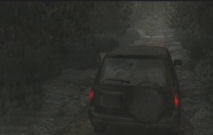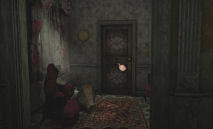In the tradition of epic movies, Got Game recently
issued a Director's Cut, or improved edition of Scratches.
The new Scratches: Director's Cut (the DC) consists of the original
Scratches game with visual and auditory enhancements, plus the
addition of a Hint System and a Diary. There is also a brief end sequence
called "The Last Visit," in which a reporter explores the Blackwood
Mansion, scene of the original game, to find out what actually happened
during author Michael Arthate's ill-fated tenure there.
If you have not yet purchased and played Scratches, you should
consult
Inferno's review of the original game. If you do decide to try the
game, I recommend that you buy Scratches: Director's Cut, rather
than the older version because the DC's enhancements do make the
experience more rewarding.
From this point on, this review is addressed to gamers who, like me,
purchased and played the original Scratches months ago. These
gamers have experienced the terrors and amusements of the original, and
this review aims to help them decide whether they should also buy the
Director's Cut version.
Visual Enhancements
The gameplay in the DC is almost exactly the same as in the original,
so the DC's added value lies elsewhere. For example, the graphics in the
DC are significantly improved. The resolution is sharper, making details
more vivid. Everything seems more real. For instance, you can now clearly
see the many surfaces of the crystals in the chandeliers, the distinct
patterns of lace in the curtains, the nubby texture of the altar cloths,
and the way light lingers in the wooden grooves of the parquet floor.
The sky in the original Scratches was always grey. In the DC,
the exteriors reflect the time of day. Dawn and dusk are particularly
memorable, with brightly colored skies. When the clock in the entryway to
the Blackwood Mansion shows that time has advanced, you can wander around
the grounds, admiring the variations in the light. There are many places
where you can gaze at the intricate shapes of leaves and branches as they
are framed against the constantly changing sky.
Auditory Enhancements
The sounds in this version of the game are more distinct. Footsteps
echo more ominously. The eerie metallic sounds in the greenhouse jangle
more nerverackingly. The human voices chanting in the chapel have an
increased intensity. I could distinguish a whispered word from a
disembodied voice that, in the original game, was unintelligible.
The Hint System
There is a Hints feature in the Main Menu, which I turned on at the
beginning of the game. However, aside from a comment at the beginning that
explained the game's interface, the hints were so subtle as to be almost
undetectable.
In both the original Scratches and the DC, you can explore large
portions of the house and grounds from the beginning without having to
solve many puzzles. The gameplay itself becomes quite linear, however.
Progress is achieved by accomplishing certain tasks at certain times. Time
on the entryway clock advances when you hit important "triggers" -- by
solving puzzles (most of which are inventory based) or by having a
telephone conversation, or by reading a key piece of information. Despite
having played the game before, I found that at times I wandered about not
knowing what to do next or what trigger I had failed to activate. The Hint
System did not help me get on track or identify the missed triggers.
The Interface
Movement is greatly improved in the DC because the game now uses
central cursor panning. The movement from node to node -- and particularly
the 360 degree panning -- is much less awkward than in the older version.
Inadequate save game slots were a downside in the original Scratches;
the deficiency persists in the DC.
Notes on Gameplay
Except for the new content in "The Last Visit," the gameplay in the DC
is the same as in the original game. Although I did remember some puzzle
solutions from last year's playthrough, there were plenty of challenges I
had forgotten -- especially inventory items that I didn't remember how to
use. I found the game to be plenty challenging after several months away
from it.
Scratches features many hotspots (some hard to find) that permit
the player to take a closer look at things. In an improvement, at least
two of these important hotspots were much easier to find in the DC
version.
However, as in the original, some hotspots are too close together. A
couple of times I used an inventory item on a hotspot, found it didn't
work, and wandered around wondering what else to do. I finally consulted a
walkthrough...only to find that my original idea was correct, and that I
must have somehow clicked on a neighboring hotspot, which gave a
non-response to the item. Further, a few shadows may have been
"over-enhanced," making it tougher to distinguish items or features in
them. This posed a particular obstacle with the puzzle box in the DC
version.
Diary
The Diary is an excellent addition to the original game. You gain
insight into what Michael Arthate is thinking. The diary explains some of
his motivations, and occasionally notifies the gamer that something is
particularly important. Other than the Diary and hints, the writing in the
DC is unchanged -- conversations on the phone are the same (as far as I
could tell), as are Michael's comments when he examines things.
Atmosphere
Scratches, before the DC enhancements, was already a
tremendously atmospheric game. This is due not just to the environments
and the music, but to the way the story unfolds. The visual and auditory
upgrades enhance the atmosphere, making the old Blackwood mansion a
richer, more colorful place to experience.
However, playing a game like Scratches a second time necessarily
diminishes the dramatic tension somewhat because the gamer already knows
where the scary bits occur. I found the replay in the DC version more
relaxing, as I wasn't terrified every time I opened a new door. But I did
miss that almost constant heart-skips-a-beat feeling. On the other hand, I
looked at the approaching sequences where I knew I was going to be
terrified with an extra dollop of dread, knowing that the inevitable was
approaching. I even tried to avoid one frightening dream sequence, but the
game drives you there relentlessly, each mouse click like a step towards
doom.
Stability
The game installed beautifully. I had purchased the version that later
required a patch and an update. The patch was a bit tricky, as I had to
unzip it into the correct file directory, and the necessity of doing this
was not immediately obvious. (For those who do need to apply the patch,
install it to C:\Program Files\Scratches Director's Cut, which is the
default setting when you first install the game.) Since then, the
publisher (Got Game) has released the full version that ships on two disks
and includes the patch and update. If you do find that you need the patch,
information about it is available
here.
While playing the DC, I experienced several jarring crashes to the
desktop. Halfway through, I updated the video drivers on my computer.
After the update, I experienced only one crash.
The Last Visit
Now we approach the portion of the game that is all new -- "The Last
Visit." This new content contains two multi-step puzzles and shows you the
Blackwood Mansion several years after the events of the original game. It
also answers some of the questions raised by the original game's ending.
I didn't find any plot surprises in "The Last Visit." What I did find
was a surprising insight into my own soul. I cared much more about what
had happened to the house in the intervening years, than for what had
happened to the characters. When I played Scratches I felt more "at
home" in the Blackwood Mansion than in any other virtual domicile I've
inhabited. It was disturbing to view the changes to it in "The Last
Visit." The new content in this part of the game is relatively short,
involving about an hour's worth of exploration and puzzling.
To Buy or Not to Buy?
As I noted at the outset, if you've never played this game, I strongly
recommend purchasing the DC. Scratches is a classic horror
adventure that shouldn't be missed, and the DC is the classic game, only
better. If you've already played the original game and enjoy replays, I
would recommend buying the DC -- particularly if you have questions left
over from the plot of the original game, because you will find some
answers in "The Last Visit." However, if you don't have an appetite for replays, the brief new
content in "The Last Visit" may not be sufficient to justify its purchase.
My Computer Specs:
Windows XP Professional
Pentium 2.80 GHz
2046 MB RAM
Direct X 9.0c
512 MB NVIDIA GeForce 7800 GTX
SB X-Fi Audio
July 2007
design copyright ©
2007
GameBoomers
Group



